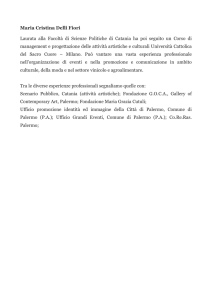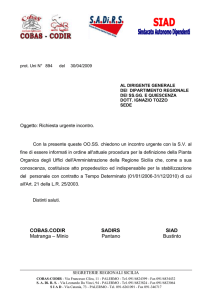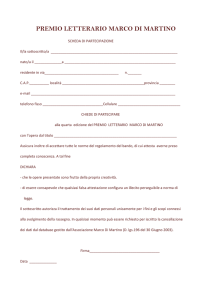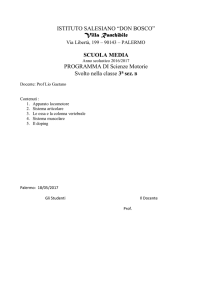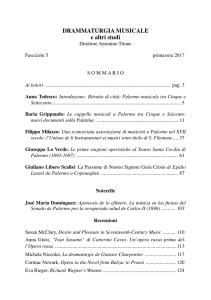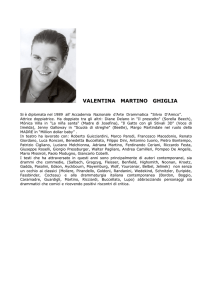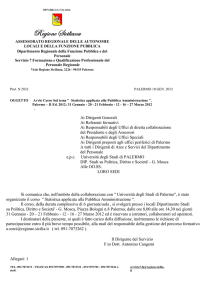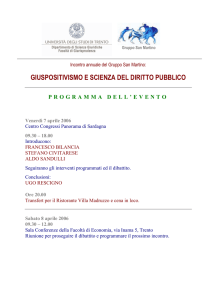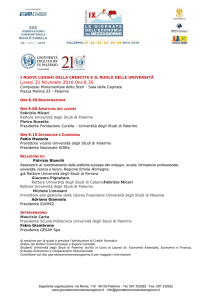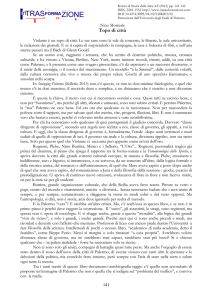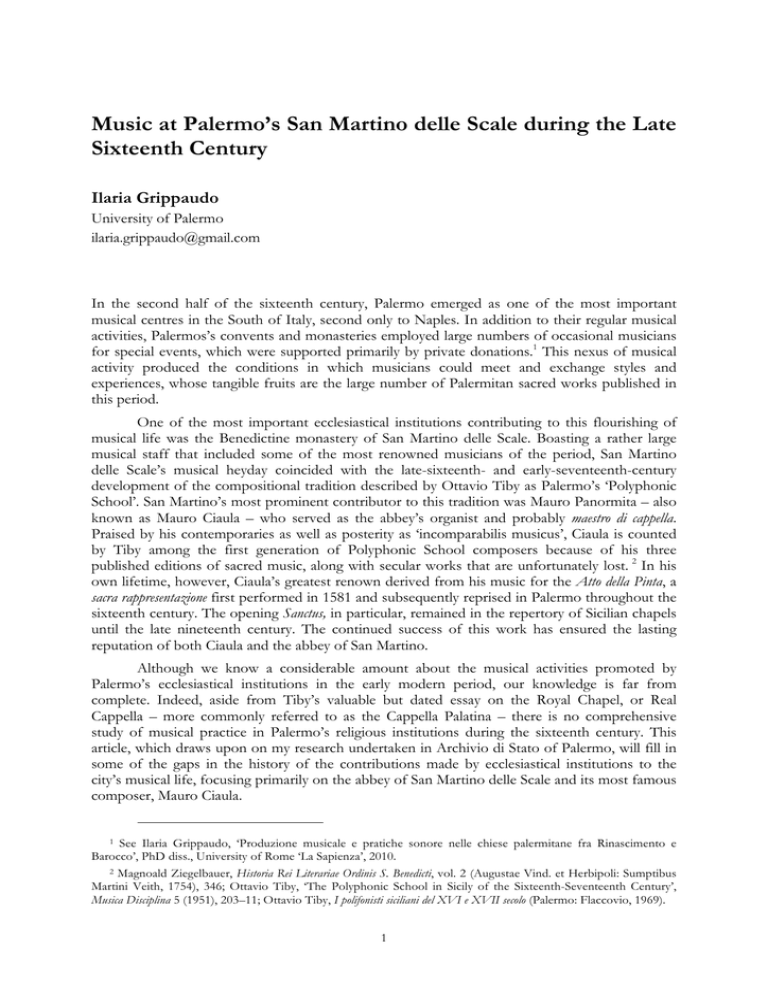
Music at Palermo’s San Martino delle Scale during the Late
Sixteenth Century
Ilaria Grippaudo
University of Palermo
[email protected]
In the second half of the sixteenth century, Palermo emerged as one of the most important
musical centres in the South of Italy, second only to Naples. In addition to their regular musical
activities, Palermos’s convents and monasteries employed large numbers of occasional musicians
for special events, which were supported primarily by private donations.1 This nexus of musical
activity produced the conditions in which musicians could meet and exchange styles and
experiences, whose tangible fruits are the large number of Palermitan sacred works published in
this period.
One of the most important ecclesiastical institutions contributing to this flourishing of
musical life was the Benedictine monastery of San Martino delle Scale. Boasting a rather large
musical staff that included some of the most renowned musicians of the period, San Martino
delle Scale’s musical heyday coincided with the late-sixteenth- and early-seventeenth-century
development of the compositional tradition described by Ottavio Tiby as Palermo’s ‘Polyphonic
School’. San Martino’s most prominent contributor to this tradition was Mauro Panormita – also
known as Mauro Ciaula – who served as the abbey’s organist and probably maestro di cappella.
Praised by his contemporaries as well as posterity as ‘incomparabilis musicus’, Ciaula is counted
by Tiby among the first generation of Polyphonic School composers because of his three
published editions of sacred music, along with secular works that are unfortunately lost. 2 In his
own lifetime, however, Ciaula’s greatest renown derived from his music for the Atto della Pinta, a
sacra rappresentazione first performed in 1581 and subsequently reprised in Palermo throughout the
sixteenth century. The opening Sanctus, in particular, remained in the repertory of Sicilian chapels
until the late nineteenth century. The continued success of this work has ensured the lasting
reputation of both Ciaula and the abbey of San Martino.
Although we know a considerable amount about the musical activities promoted by
Palermo’s ecclesiastical institutions in the early modern period, our knowledge is far from
complete. Indeed, aside from Tiby’s valuable but dated essay on the Royal Chapel, or Real
Cappella – more commonly referred to as the Cappella Palatina – there is no comprehensive
study of musical practice in Palermo’s religious institutions during the sixteenth century. This
article, which draws upon on my research undertaken in Archivio di Stato of Palermo, will fill in
some of the gaps in the history of the contributions made by ecclesiastical institutions to the
city’s musical life, focusing primarily on the abbey of San Martino delle Scale and its most famous
composer, Mauro Ciaula.
See Ilaria Grippaudo, ‘Produzione musicale e pratiche sonore nelle chiese palermitane fra Rinascimento e
Barocco’, PhD diss., University of Rome ‘La Sapienza’, 2010.
2 Magnoald Ziegelbauer, Historia Rei Literariae Ordinis S. Benedicti, vol. 2 (Augustae Vind. et Herbipoli: Sumptibus
Martini Veith, 1754), 346; Ottavio Tiby, ‘The Polyphonic School in Sicily of the Sixteenth-Seventeenth Century’,
Musica Disciplina 5 (1951), 203–11; Ottavio Tiby, I polifonisti siciliani del XVI e XVII secolo (Palermo: Flaccovio, 1969).
1
1
Ilaria Grippaudo, Music at Palermo’s San Martino delle Scale during the Late Sixteenth Century
Mousikos Logos – Issue 2 (January 2015) – ISSN: 1108-6963
Music in Palermo
As early as the eleventh century, the Normans had promoted refined musical performances in the
context of official ceremonies and private occasions. Music was thus considered an essential
aspect of court life, playing an important role in festive ritual. It was not until Aragonese rule
(1282-1402), however, that the idea of the ‘feast’ as a total event reached its full expression,
relying on standardized elements and a combination of visual, auditory, olfactory, and even
gustatory stimuli. In this setting, music, along with all these aspects of the Aragonese courts
feasts, was considerably developed in conjunction with the broader evolution of tastes at court.3
The Quattrocento opened with the Compromise of Caspe 1412, whereby the Kingdom
of Sicily lost its independence and was annexed to the Spanish crown. From then until the
eighteenth century, the island was ruled by Spanish viceroys who often showed little interest in
improving local cultural life. Indeed, the majority of these Spanish governors regarded Sicily as a
foreign domain whose chief purpose was to provide rather high tax revenues and to serve as a
buffer against the Ottoman Empire. It is thus not surprising that the viceroys did little to enhance
the musical prestige of Sicilian institutions, especially in the first century of Spanish rule.
Among the viceroys appointed in the sixteenth century, Marcantonio Colonna stands out
as one of the few who contributed to the development of Palermo’s musical life. Indeed,
Colonna’s intervention in the late Cinquecento resulted in the revival of the Cappella Palatina,
which had traditionally been Palermo’s most prestigious musical organization. Colonna paid
special attention to the chapel’s musical establishment, which he reconstituted in January 1584
with seven of his soldiers who happened to be particularly skilled in music. Two years later, King
Philip II, acquiescing to Colonna’s requests, issued a royal decree officially founding the new
cappella musicale with a significant annual endowment.4 This new institution was mainly
preoccupied with promoting the viceroy’s strong public image, as confirmed by descriptions and
account books, which attest to the participation of the chapel at the numerous feasts in the local
civic and liturgical calendar.
In addition to the Palatina, Palermo’s other two main chapels – those of the Cathedral
and the Senate – along with various other institutions, offered important musical events, whether
within their own premises or publicly in the city. It is difficult to be certain about the number of
ecclesiastical institutions that were active in the urban area during the sixteenth and the
seventeenth centuries. This is due to the frequency of their foundation, the mobility of religious
communities generally, and the absence clear indications in the sources. Nevertheless, according
to a census held in Palermo in 1613, the city had no fewer than twenty-three convents and fifty
churches attached to monasteries and novitiates, and these accommodated a population of about
24,000 souls, for a total of 140,000 inhabitants.5 Besides performing music for the normal liturgy,
these numerous religious institutions contributed to local musical life by supporting various
special occasions, most commonly for religious feasts, but also ordinations, funerals, and
investitures, which were mainly supported by private funding.6
3
See Giovanni Isgrò, Festa teatro rito nella storia di Sicilia (Palermo: Cavallotto Editore, 1981), especially 50, 70, 83–
4.
4 Ottavio Tiby, ‘La musica nella Real Cappella Palatina di Palermo’, ‘Anuario musical’ dell’Istituto Español de
Musicologia del C.S.I.C. 7 (1952), 180–2.
5 Francesco Maggiore-Perni, Statistica della città di Palermo. Censimento della popolazione nel 1861 pubblicato dall’Ufficio
Comunale di Economia e Statistica (Palermo: Francesco Lao, 1865), cii–civ.
6 See Grippaudo, ‘Produzione musicale’.
2
Ilaria Grippaudo, Music at Palermo’s San Martino delle Scale during the Late Sixteenth Century
Mousikos Logos – Issue 2 (January 2015) – ISSN: 1108-6963
All of Palermo’s congregations promoted musical activities more or less continuously.
Still, because their musical organizations took various unstandardized forms in the sixteenth and
seventeenth centuries, the task of identifying individual chapels proves difficult. It would appear
that, other than the Cathedral Chapel and the Palatine Chapel, the only ecclesiastical musical
chapel sensu stricto was the Jesuits’, which operated from the first half of the Seicento.7 On the
other hand, numerous sources allude to the existence of other stable organizations of personnel
that, while not designated as such in the sources, nevertheless appear to have functioned similarly
to proper musical chapels. These musical organizations were primarily affiliated with monasteries
and convents.
Mapping the geography of these affiliations reveals a relatively even distribution across
Palermo’s four districts, perhaps indicating an implicit agreement regarding the division of
jurisdictions within the city.8 Constant competition between the prominent urban congregations,
however, challenged this apparent balance and was sometimes centred on musical issues.9 During
the medieval period the dominance of monastic orders like as the Basilians and Cistercians
gradually shifted towards other congregations, especially the Benedictines, Franciscans, and
Dominicans. Since then these latter orders had been increasingly active in Palermo and
throughout Sicily. These orders maintained their prominence in Palermo through the end of
seventeenth century, despite the arrival of the Jesuits, Theatines, and Oratorians, starting in the
sixteenth century. Clashes and rivalries among different orders were not uncommon and often
escalated to rather aggressive conflicts that played out in territorial and ideological terms. Among
the ideological points of contention was the concept of the ‘consumption of devotion,’ which is
essential for understanding the role of music in convents and monasteries in the sixteenth and
the seventeenth centuries.10
On the Jesuits and their musical activities, see Ilaria Grippaudo, ‘I Gesuiti e la musica a Palermo fra
Rinascimento e Barocco’, in Musica tra Storia e Filologia. Studi in onore di Lino Bianchi, ed. Federica Nardacci (Rome:
Istituto Italiano per la Storia della Musica, 2010), 279–311.
8 This perspective owes much to the approach of the so-called ‘urban musicology’, which recognises the function
of all the institutions included within the civic space and considers music itself as an essential component of the
urban experience. See Tim Carter, ‘The Sound of Silence: Models for an Urban Musicology’, Urban History 29/1
(2002), 8–18. Regarding Palermo, see Anna Tedesco, ‘La ciudad como teatro: rituales urbanos en el Palermo en la
Edad Moderna’ in Música y cultura urbana en la Edad Moderna, ed. Andrea Bombi, Juan José Carreras, and Miguel Ángel
Marín (Valencia: Universitat de València-IVM, 2005), 219–42; Ilaria Grippaudo, ‘Musica Urbana: Musica e cerimonie
all’aperto nella Palermo di Cinque e Seicento’, in Studi sulla musica dell’età barocca, ed. Giorgio Monari (Lucca: LIM,
2012), 77–133.
9 An example is provided by the Theatines, who established themselves in Palermo at the beginning of the
seventeenth century, initially in the monastery next to the church of the Catena and then moving to a larger and
definitely more strategic site within the new developing layout of the city. According to archival sources, shortly
before their move they were involved in a controversy over the building of a ‘place’ for secular music, perhaps a
theatre or, more probably, a platform to be placed in the righthand corner of the church. The Theatines’ determined
opposition to this proposal led to the prompt intervention of the Viceroy, Francesco Lemos, Count of Castro, who
called for an immediate interruption to the work, already begun and probably commissioned by the town Senate.
Archivio di Stato di Palermo [henceforth, ASPa], Corporazioni Religiose Soppresse, Casa dei Padri Teatini, vol. 857,
p. 2a. NB: many of the documents cited in this study utilize a pagination system in which the two facing pages – i.e.,
the verso of one folio and the recto of the next one – are given the same page number. In these cases, I have
preserved the given pagination and indicated the lefthand (verso) page with the letter ‘a’ and the righthand (recto)
page with a ‘b’.
10 See Angelo Torre, Il consumo di devozioni. Religione e comunità nelle campagne dell’Ancien Régime (Venice: Marsilio,
1995); Francesco Lo Piccolo, ‘Veicoli di diffusione del culto e consumo della devozione dell’Immacolata nel
Palermitano (secoli XVI-XVIII)’, in La Sicilia e l’Immacolata. Non solo 150 anni, Atti del Convegno di Studi (Palermo, 1–4
dicembre 2004), ed. Diego Ciccarelli and Marisa Dora Valenza (Palermo: Biblioteca Francescana – Officina di Studi
Medievali, 2006), 279–90.
7
3
Ilaria Grippaudo, Music at Palermo’s San Martino delle Scale during the Late Sixteenth Century
Mousikos Logos – Issue 2 (January 2015) – ISSN: 1108-6963
Musical Activities at San Martino delle Scale: Liturgical Chant, Performing
Practices, and Festive Occasions
Probably due to its location, about fifteen kilometres outside the city walls, the Benedictine abbey
of San Martino delle Scale seems to have avoided the most sensational quarrels, despite being
among the leaders of the local musical scene. According to tradition, the abbey was founded by
Gregory the Great in 590 and then destroyed by the Saracens in the ninth century. Whatever the
truth may be, it is certain that the edification of the present building – or re-edification, as it is
often called in the sources – dates back to 1347, when Angelo Senisio was called by the
Archbishop of Monreale, Emanuele Spinola, to establish a colony of Benedictine monks on its
location.11
The archive of the abbey is a rich source of information, the majority of which is now
preserved at the Archivio di Stato of Palermo. Comprising more than 2,000 items in two separate
sections, the archive covers an 800-year period, from the twelfth through the nineteenth century.
This massive collection of documents is composed of various types of registers: the giornali, in
which daily expenditures were recorded; income and expense books; registers of receipts; and the
vacchette, small-size volumes that frequently offer interesting information on musical topics. With
few exceptions these kinds of archival records say little about the relationship between music and
ordinary liturgy. For such information, it is necessary to consider other types of documents, such
as the Regie Visite, which are official reports drafted by a royal officer during the monitoring visits
in churches and dioceses of the island.12
A rather curious piece of evidence pointing to the importance of liturgical chant in
monastic culture can be found in the Ordinationes speciales Capituli generalis, pro monasterio Sancti
Martini, excerptæ a suis originalibus, amputatis superfluis et non necissariis, which documents official visits
to the abbey from 1511 to 1606. The structure and content of the Ordinationes is quite similar to
that of the Regie Visite, and some provide information on the presence of chant in the liturgy. For
example, in 1512 the visitors ordered that a mass for the devotion of the glorious Virgin – ‘ob
devotionem gloriosæ Virginis’ – should be sung every Saturday, specifying that ‘if Saturday is a
feast day, then the missa plana has to be held after the first one, at the major altar’.13 Other
information, mostly belonging to the second half of the sixteenth century, attests to the
involvement of the organist and to some restrictions on the use of musical instruments (see
below). Here I refer to two letters from 1585 concerning a Benedictine monk, Iacopo da
Palermo, who had left the order some years before. The first letter, which bears Iacopo’s
signature, is a petition addressed to the visitors to reduce the remaining time on the monk’s jail
sentence, which he felt had been particularly hard in light of his being old and sick. In
For the general history of the monastery, see Rocco Pirri, Sicilia Sacra disquisitionibus et notitiis illustrata, ed.
Antonino Mongitore and Vito D’Amico, vol. 2 (Palermo: heirs of Pietro Coppola, 1733), 1072–107; Gregorio
Frangipani, Storia del monastero di San Martino delle Scale presso Palermo (Assisi: Tip. Metastasio, 1905); Paolo Collura,
‘Storia e cultura nel monastero di S. Martino delle Scale presso Palermo’, Schede Medievali 4 (1983), 52–67; Anselmo
Lipari, L’abbazia di San Martino delle Scale: storia, arte, spiritualità (Palermo: Poligraf, 1989); Angelo Sinisio e i primordi
dell’abbazia di San Martino, Mostra storico-documentaria (Palermo, Abbazia di San Martino delle Scale, 20 luglio-18 agosto 1996),
ed. Fabrizio Messina Cicchetti, (Palermo: Officina della memoria, 1996); L’eredità di Angelo Sinisio. L’abbazia di San
Martino delle Scale dal XIV al XX secolo, catalogo della mostra (Palermo, Abbazia di San Martino delle Scale, 23 novembre 199713 gennaio 1998), ed. Maria Concetta Di Natale and Fabrizio Messina Cicchetti (Palermo: Regione Siciliana –
Assessorato dei Beni Culturali, Ambientali e della Pubblica Istruzione, 1997); De reedificatione monasterii Sancti Martini de
Scalis, ed. Diego Ciccarelli (Palermo: Abadir, 1997).
12 Paolo Collura, ‘Le sacre regie visite alle Chiese della Sicilia’, Archiva Ecclesiæ 22-23 (1979-1980), 443–51.
Throughout this article, all English translations of archival materials are my own. Nevertheless, I am most grateful to
Carrie Churnside for her invaluable assistance with the translations.
13 ASPa, Corporazioni Religiose Soppresse, San Martino delle Scale – fondo II, vol. 1467, fol. 1r.
11
4
Ilaria Grippaudo, Music at Palermo’s San Martino delle Scale during the Late Sixteenth Century
Mousikos Logos – Issue 2 (January 2015) – ISSN: 1108-6963
reconstructing his history, the monk mentions, albeit briefly, the reasons that prompted him to
leave the order, referring to the fear of not performing up to the choir’s singing standards:
Io Don Iacobo di Palermo Monaco, et professo di questo Monasterio di
Santo Martino havendo stato alcuni anni fuora della religione, havendomi
partito dal Monasterio di Monreale per timidità di non poter sodisfar al
cantare in choro, come vi potranno far fede il Reverendo Padre Don Isidoro
Abbate nostro, et il Venerando Padre Don Martino Priore di Monreale, et il
Padre Don Gregorio di Santo Angelo nostro Decano. Ultimamente mi
presentai nel capitolo generale prossimo passato in Peruggia, dove fui
ricevuto in congregatione, havendo tutti li RR. PP. del capitolo buon
testimonio della vita mia fuora la congregatione per lettere di Monsignor
Arcivescovo di Genua, dove stetti per alcuni anni. Trovandomi oggi in quisti
carceri supplico humilmenti le PP. VV. RR. amore Dei, per trovarme vecchio
et indisposto, travagliato, mi vogliano haver misericordia in allargarme detta
carcere, acciò non incorra in qualche infermità incurabile, promettendo alle
PP. VV. RR. di emendar la vita mia, et perseverar nella santa religione per fin
al fine della vita mia. La presente ho scritto in questi carceri, del nostro
Monastero de Santo Martino delli Scali di Palermo, primo settembre 1585.14
(I, Don Iacobo di Palermo, a monk professed in this monastery in St.
Martino, as I have been out of the order for some years, after leaving the
monastery of Monreale from the fear of not performing up to the choir’s
singing standards, as Reverend Father D. Isidoro, our abbot; and Venerable
Father Don Martino, prior of Monreale; and Father Don Gregorio di Santo
Angelo, our dean can attest. Recently I presented myself to the last general
chapter in Perugia, where I was accepted into the congregation, since all the
Reverend Fathers of the chapter testified to my good conduct outside the
order, thanks to the letters of Monsignor the Archbishop of Genua, where I
stayed for some years. Being at present in this prison, I humbly beg Your
Reverend Fathers for God’s sake to have mercy in reducing this jail sentence,
since I am old and sick, and afflicted, and so that I may avoid catching an
incurable disease, while promising to amend my behaviour, and to persist in
this religion until the end of my life. I have written this [letter] in this prison
of our monastery of St. Martino delle Scale in Palermo, on 1 September
1585).
In the second letter, Don Isidoro, abbot of San Martino, further attests to the good
conduct of the prisoner, renewing the supplication to the visitors and confirming what had been
written in the preceding text:
Sono circa anni sedici, chè io me ritrovava monaco di Monreale insieme con
il Padre Don Martino di Palermo al presente Priore in Monreale. Occorse
s’hebbe bisogno di monaci, et il Reverendo Padre Don Geronimo di
Palermo, allora Abbate in Monreale hebbe ricorso dal Reverendo Padre Don
Benedetto di Firenze Abbate di San Martino, et da quello hebbe duoi monaci,
e fra essi fù D. Iacobo supplicante, quale essendo in San Martino gravato di
esercitii manuali si contentò d’andare in Monreale. Et essendo andato llì dopo
alcuni mesi per l’insufficientia sua et pusillanimità si pentì, perché non poteva
sodisfar in choro, e li monaci, secolari, e donne si burlavano, et ridevano di
lui. Et havendo scritto in San Martino, che voleva ritornare, e li fu denegato,
14
ASPa, Corporazioni Religiose Soppresse, San Martino delle Scale – fondo II, vol. 1467, fol. 66v.
5
Ilaria Grippaudo, Music at Palermo’s San Martino delle Scale during the Late Sixteenth Century
Mousikos Logos – Issue 2 (January 2015) – ISSN: 1108-6963
intanto che ritrovandose in Monreale allhora un monaco per nome Don
Bernardo de Coniglione, huomo disculo, lo indusse, per quanto ho inteso, a
lasciar e partirse dalla religione e così esequirno.15
(It is now around sixteen years ago that I was a monk in Monreale, along with
Father Don Martino, at present prior in Monreale. It happened that we
needed some monks, and Reverend Father Don Geronimo di Palermo,
former abbot of Monreale, sought help from Reverend Father Don
Benedetto di Firenze abbot of St. Martino, and from him he received two
monks, and among them there was the petitioner Don Iacobo, who was
satisfied to go to Monreale, since at St. Martino he was burdened with manual
labours. Having gone there, after a few months he regretted it because of his
inadequacy and pusillanimity, since he could not perform up to the choir’s
standards, and the monks, the secular people, and the women made fun of
him and sneered at him. And after having written to St. Martino that he
would like to come back, and since that was denied to him, while a monk
named Don Bernardo de Coniglione, an unruly man, was in Monreale, this
latter forced him [Don Iacopo] to go away and leave the order – as far as I
know – and thus it happened.)
In referring to the past life of Don Iacopo, the abbot focused on his years in Monreale,
also mentioning the fear to which the petitioner had only alluded, and which had caused great
derision from the other monks, the laymen, and even the women. This underscores the
importance of singing ability, since its absence could attract ridicule and laughter among the
congregation or even cause the culprit to depart from the religious order. It is also likely that Don
Iacopo’s singing ineptitude was the main reason for the manual labours that he had to carry out
in San Martino and the decision to send him to Monreale. Among the other things, the abbot
reiterates several times the good reputation of the monk and his honourable behaviour, adding
that ‘what he is lacking in the choir setting, he makes up for in manual labours’.
These two letters also allude to the close relationship at the time between San Martino
delle Scale and the Archbishop of Monreale, under whose jurisdiction the abbey fell. The
exchange of performers and singers between these two institutions was rather frequent, and the
fine craftsmanship of the choral books produced in the monastic scriptorium suggests the high
level of their skills. Many of these manuscripts date from the sixteenth century and are valuable
resources for the reconstruction of the abbey’s liturgical practice.16
Although the account books of San Martino contain numerous references to singers, in
most cases it is not possible to establish whether they were permanently in the abbey’s employ. In
fact, the archival documents for this period provide no evidence of an officially institutionalized
cappella musicale at the abbey, although circumstantial evidence suggests its existence. For instance,
a payment note dated 1576 appears to offer the earliest evidence musicians receiving a monthly
salary from the institution.17 While this does not confirm the existence of an institutionalized
musical chapel, one must remember that during the sixteenth century the organization of musical
ASPa, Corporazioni Religiose Soppresse, San Martino delle Scale – fondo II, vol. 1467, fol. 66v.
Angela Daneu Lattanzi, I manoscritti ed incunaboli miniati della Sicilia, vol. 1 (Rome: Istituto Poligrafico dello Stato,
1965), 235–7; Maria Concetta Di Natale, ‘Argentieri e miniatori a San Martino delle Scale’, in L’Abbazia di San
Martino delle Scale: Storia, Arte, Ambiente, ed. Anselmo Lipari (Palermo: Poligraf, 1990), 132–5; Il fondo antico della Biblioteca
Pax di San Martino delle Scale: Corali miniati e cinquecentine, ed. Elisabetta Lo Coco and Silvestre Zuccarello (Palermo:
Officina della memoria, 2001); Maria Concetta Di Natale, ‘Arti decorative nell'abbazia di San Martino delle Scale’, in
Lo splendore di un chiostro: Guida storico-artistica dell'Abbazia di San Martino delle Scale, ed. Anselmo Lipari and Fabrizio
Messina Cicchetti (Palermo: Abadir, 2002), 77–96.
17 ASPa, Corporazioni Religiose Soppresse, San Martino delle Scale – fondo II, vol. 756, fol. 25r.
15
16
6
Ilaria Grippaudo, Music at Palermo’s San Martino delle Scale during the Late Sixteenth Century
Mousikos Logos – Issue 2 (January 2015) – ISSN: 1108-6963
staff in Palermo’s churches was generally flexible and heteromorphic. If we accept Oscar
Mischiati’s broad definition of cappella musicale, one may justifiably hypothesize that already in the
Cinquecento San Martino employed ‘a group of cantori and players who were in the permanent
service of [the] church under the supervision of a maestro (who sometimes was also the
organist)’.
For special occasions of the church calendar, outside musicians supported the abbey’s
regular musical personnel. The recruitment of professional performers, both singers and
instrumentalists, is noted for the patronal feast of San Martino; for the feast of San Benedetto,
founder of the order; and for other occasions that required increased musical activity, such as
Marian feasts, Christmas, and Lent. These additional musicians were compensated either with
money or, more frequently, food and commissions.18 Among the most popular food items were
fruits and sweets, such as mustazzola, diamond-shaped cookies made with honey and wine; cubaita,
crispy sweets for the Christmas period; confezioni (jams); and above all the nivi (snow) that was
used to produce ice creams and sorbets. The distribution of fish was also very common, and it
was reserved for the musicians hired for the Lent period, following the canonical Christian
prescriptions. Such in-kind payments were sometimes also made to the abbey’s organists. The
registers for the years 1580-1585 indicate that the organist was entitled to food and stromenti di
letto (accommodation commodities), in addition to his regular salary. Most importantly, he was
also provided with cavalcature, or mounts, which were most likely necessitated by the monastery’s
distance from Palermo and Monreale. The cost of these extra perks, combined with normal
monetary payments, brings the monastery’s expenditure on compensation for the organist to a
total of 13 onze per year.19
In addition to the organist, trumpeters and players of piffari (various types of woodwind
instruments) were added to the cantori and other regular personnel to perform for major feasts.
These instruments enhanced the solemnity of the celebrations and also attracted large
congregations. This explains their appearance in virtually all the celebrations of feasts of the
patron saints. Also noteworthy is the abbey’s use of wind instruments for Pentecost, which
doubled as the titular celebration of its grancia (i.e., dependent church) in Palermo, named for the
Holy Spirit. Besides being a public display of devotion, the Pentecost celebrations of the Church
of the Holy Spirit served to project San Martino’s institutional power directly to Palermo’s
citizens, despite the monastery’s physical distance from the city. Somewhat puzzling, given the
massive amount of extant documentation, is that little information has survived regarding
sixteenth-century celebrations for the feasts of the patron saints, San Martino and San Benedetto.
Perhaps it was deemed unnecessary to supplement the abbey’s regular musical personnel,
whether or not organized into a functional cappella musicale, with external musicians.
Conversely, the celebrations for Carnival and Lent are widely documented from the first
half of the sixteenth century since the liturgical celebrations of period were of primary
importance for the city. Indeed, the tradition during Lent was for each church in Palermo to
solemnize the feast, giving the whole city the aura of a holy place. Accordingly, extant records
attest to rather elaborate musical performances, for which additional musicians and singers were
apparently brought in to join the regular personnel of all of Palermo’s ecclesiastical institutions.
San Martino, of course, played a leading role in these celebrations, indirect evidence for which
This widespread practice endured throughout the city at least until the second half of the nineteenth century.
The monetary units used in Sicily were, in order of increasing value, grana, tarì (1 tarì = 20 grana), and onze (1
onza = 30 tarì). In 1862, after the Italian unification, onze and tarì were converted into lire, such that 1 onza was valued
as 12.74 lire, and 1 tarì as 0.42 lire. For previous centuries it is difficult to estimate precise values, but we do know that
in 1548 a mule cost around 6 to 11 onze, a horse 5 onze, an ox 3 onze, a barrel of wine 1.5 onze, a cow 1.2 onze, a pig 6
tarì, and a sheep 5 tarì.
18
19
7
Ilaria Grippaudo, Music at Palermo’s San Martino delle Scale during the Late Sixteenth Century
Mousikos Logos – Issue 2 (January 2015) – ISSN: 1108-6963
can be found it the account books that note increased expenditures for strings and conzature
(repairs) of musical instruments.
Organists, Teachers, and Musicians
In contrast to the scant information regarding music in Palermo’s other ecclesiastical institutions
during the Quattrocento, payments to the organists of San Martino delle Scale are recorded from
second half of the fifteenth century. An entry from 1478 records the donation of 6 tarì to father
Pietro to be paid to ‘father Janni Janellu, player of the organ’, whose duties included teaching
Pietro and other monks to play the instrument ‘to honour the divine worship’.20 A memorandum
inserted into the book – a slip of paper, or pizzino, as it was often called by copyists – informs us
that the abbot had ordered the cellarer to renegotiate the fee for the organ teacher due to the
limited number of monks; namely 6 ducats to be paid in three instalments over a period of three
weeks, plus the immediate payment of 2 ducats as a compensation for the services of the first
week.
For the sixteenth century we can confirm sustained collaboration with numerous
organists performed for the regular liturgy and on solemn occasions, whether in the abbey or its
grancia. Generally, changes of organist were apparently infrequent, and the abbey seems not to
have employed multiple organists simultaneously. Rather, the records suggest the presence of a
single salaried organist who was replaced as soon as he finished his appointment. Other organists,
who were perhaps recruited from outside to teach music or perform, joined the permanent player
only occasionally and for special events, particularly during Easter and Christmas. The earliest
sixteenth-century record for such an engagement dates from November 1526. This payment to
the organist from Monreale, probably in connection with the feast of San Martino, underscores
the importance of the abbey’s relationship with the archdiocese.21 Five years later, on 29
December 1531, we find a larger payment of 13 tarì to Pietro Fresina to play the organ at San
Martino during Christmas.22 Although this could be an occasional performance, the amount of
the payment suggests that it might be part of the salary, in which case Fresina would have been
the permanent organist of the monastery. Indeed, this would be consistent with the institution’s
common practice of compensating its permanent organists with single payments of 13 or 26 tarì.
The permanent organists also included a certain Lentomello, to whom Don Girolamo
paid 12 tarì in 1535.23 However, in July 1536 regular payments are recorded for Giovanni Antonio
Ansilio (or Ausilio), a new organist who would remain continuously at San Martino for about
thirty-five years. Ansilio received a bimonthly salary of 13 tarì, for a total of 2 onze and 6 tarì per
year. This sum was paid through private banks, such as those of Torongi and Scirotta, and almost
always by the abbot, the cellarer, or Antonio Venitiano from Monreale.24 By the mid-sixteenth
century this annual salary had been significantly increased to 4 onze. From 1568 until 1587 we find
no further information about Ansilio. Leaving aside for the moment Mauro Ciaula, who will be
discussed later, during that period four successive performers held the post of organist: Giulio
Guido in 1574, Girolamo Catalano in 1576 and 1577, Girolamo di Sabato in 1577 and 1578, and
Antonio Cadili (or Candili) from Monreale in 1582. At 8 onze per year, Candili’s salary was exactly
20 ‘[…] a frati Jannj Janellu sonaturi di organj, ASPa, Corporazioni Religiose Soppresse, San Martino delle Scale –
fondo II, vol. 708, p. 35b; ASPa, Corporazioni Religiose Soppresse, San Martino delle Scale – fondo II, vol. 708, p.
36b.
21 ASPa, Corporazioni Religiose Soppresse, San Martino delle Scale – fondo II, b. 1405, Libro di spese minute
1523-1526, fol. 54r.
22 ASPa, Corporazioni Religiose Soppresse, San Martino delle Scale – fondo II, vol. 721, p. 103b.
23 ASPa, Corporazioni Religiose Soppresse, San Martino delle Scale – fondo II, vol. 725, p. 34b.
24 ASPa, Corporazioni Religiose Soppresse, San Martino delle Scale – fondo II, vol. 725, p. 186a.
8
Ilaria Grippaudo, Music at Palermo’s San Martino delle Scale during the Late Sixteenth Century
Mousikos Logos – Issue 2 (January 2015) – ISSN: 1108-6963
twice the amount that was earned by Ansilio thirty years earlier. For the remainder of the
sixteenth century, the sources mention no other permanent organists, instead recording
extraordinary payments. Such payments include one in 1583 for the feast of the Assumption, one
in 1584 to Girolamo di Sabato for the Pentecost, and another in 1587 to the aforesaid Ansilio.25
The vacchette for the early seventeenth century include only one payment in 1614 to
Raffaello Li Rapi, ‘for the salary of the organ’.26 However, it is not clear whether Li Rapi was the
institution’s organist or, more likely, the organ maker. The term organista was used
interchangeably to describe either the player or the organ maker, an ambiguity of terminology
that recurs frequently in the archival sources. At any rate, the lack of information about the
organists of the seventeenth century is hardly surprising, considering that the vacchette, in contrast
to the giornali, primarily registered extraordinary payments while normally omitting payments to
permanent employees. Nonetheless, the organists continued to work regularly throughout the
century, as is attested by regular payments to one or more anonymous men employed ‘on the
margin’ to pump the bellows (alzamantici or tiramantici).
Further confirmation of the attention that the Benedictine institution paid to liturgical
music is provided by the presence of teachers of polyphonic singing and instrumental practice. In
addition to the aforementioned Janni Janellu, San Martino employed the organist Francesco Lo
Grammatico, who is found among the salaried players and was paid on 9 March 1569 either to
teach or to learn from Don Mauro (i.e., Mauro Ciaula).27 The ambiguity results from the use of
the term imparare (to learn), which often was incorrectly used as a synonym of insegnare (to teach).
We also find a record for the collaboration with Giovanni Battista Adamo, a musician of the
cappella musicale of the Senate, which presumably also dates from the same period. An undated
receipt seems to confirm that Adamo ran a school (‘teneva scola’) in the church of San Teodoro
on the Cassaro, the main street of the city.28 This is the first and, so far, only evidence that
explicitly uses the expression ‘tenere scola’ in relation to music teaching in a church of the city,
although other sources attest to the vitality of teaching activities carried out by local musicians,
both in the ecclesiastical institutions and private workshops. Indeed, the records for the sixteenth
and seventeenth centuries contain frequent references to teachers of guitar, harp, lute, and
keyboard instruments.
As for the musicians hired for special occasions, the San Martino account books often do
not record their names, at least during the sixteenth century. When names are specified, they are
generally well-known performers affiliated with the most important cappelle musicali of Palermo.
For example, in 1610 the bass Girolamo Muntiliana performed during the feast of San Martino,
for which he was compensated 1 onza.29 Thanks to the documentation of the Regie Visite, we learn
that Muntiliana was a member of the musical chapel of the Palatina.30 Another member of the
Palatina was the tenor Ottavio d’Apa, who was employed two years earlier for the patronal feast
of San Benedetto at the grancia of the Holy Spirit.31
25 ASPa, Corporazioni Religiose Soppresse, San Martino delle Scale – fondo II, b. 1135, Libro di spese minute
1583, c. 84r; fondo II, b. 1203, Libro di spese minute 1584-1585, c. 2b; fondo II, vol. 770, fol. 5v.
26 ‘[…] per lo salario dell’organo’, ASPa, Corporazioni Religiose Soppresse, San Martino delle Scale – fondo II, b.
998, Cassa 1613-1615, fol. 81r.
27 ASPa, Corporazioni Religiose Soppresse, San Martino delle Scale – fondo II, vol. 749, fol. 27v.
28 ASPa, Corporazioni Religiose Soppresse, San Martino delle Scale – fondo II, b. 1405, Spese 1520-1869.
29 ASPa, Corporazioni Religiose Soppresse, San Martino delle Scale – fondo II, b. 1137, Vacchetta 1610-1611,
fol. 32v.
30 ASPa, Conservatoria di registro, vol. 1330, fol. 222v.
31 ASPa, Corporazioni Religiose Soppresse, San Martino delle Scale – fondo II, b. 1138, Vacchetta 1617-1618,
fol. 36v.
9
Ilaria Grippaudo, Music at Palermo’s San Martino delle Scale during the Late Sixteenth Century
Mousikos Logos – Issue 2 (January 2015) – ISSN: 1108-6963
While archival records clearly demonstrate the pre-eminence of singing at San Martino
delle Scale, considerable evidence reveals that the monks regularly played musical instruments. In
fact, the earliest known payment of any kind for music at the abbey dates from the second half of
the fifteenth century and records the purchase of strings for a clavichord.32 Similar entries
continued to be registered in the following century, with many references to organs, keyboard
instruments, violins, lutes, violas, and flutes. The use of musical instruments spread to such an
extent that it caused frequent interventions by the ecclesiastical authorities, especially after the
Council of Trent. Again in the Ordinazioni del Capitolo Generale, we find a note dating back to 1578
by which the visitors forbade the monks to play instruments, a prohibition that was re-affirmed
in the following year.33
In addition to organists and singers, San Martino and other Palermitan institutions
employed outside instrumentalists for special occasions. For the years 1581 and 1582 we find
Antonino Morello, one of the most cited musicians in the account books of Palermo’s
Corporazioni soppresse. In 1577 Morello is documented as a player of woodwind instruments at the
cappella of the Senate, a role that he probably also held at the Cappella Palatina in the first years
of the following century. 34 Morello collaborated with numerous institutions, both male (San
Domenico and Casa Professa of the Jesuits) and female (Santa Maria del Cancelliere and Santa
Maria della Pietà). But his most prestigious appointment is recorded in a notary’s deed of 1595
wherein he is named maestro di cappella of the Cathedral and required to play the organ for several
occasions of the liturgical calendar.35 In 1628 Giovanni Battista Fiorenza was entrusted with the
same role, though not at the Cathedral of Palermo, but at the Dome of Monreale. This musician
had already appeared as organist of San Domenico (1606–7) and was then hired by the monks of
San Martino to play at the grancia for the feasts of San Martino and San Benedetto.36
None of the previously named musicians seems to have been active as composer,
although rental documents of San Martino provide interesting information on performers who
published music collections during the sixteenth and seventeenth centuries. For example, as early
as 1599 a number of payments attest to the presence of Vincenzo di Elia, perhaps identifiable as
the homonymous composer and maestro di cappella of the Palatina from 1636.37 In the same year
D’Elia published his only known music book, the Salmi et hinni di vesperi ariosi, a 4 e 8 voci, held
today at the Archive of the Museum of the Cathedral of Malta.38 Although it remains uncertain
whether Vincenzo di Elia is the composer of the Salmi et hinni, we have stronger clues about the
identity of a certain Antonio Lo Verso mentioned in the vacchette from the first half of the
32 ASPa, Corporazioni Religiose Soppresse, San Martino delle Scale – fondo II, b. 1405, Libro di spese minute
1569-1571, fol. 96r.
33 ASPa, Corporazioni Religiose Soppresse, San Martino delle Scale – fondo II, vol. 1467, fol. 32r.
34 Archivio Storico Comunale di Palermo, Atti del Comune 1576-1577, f. 40 (see Tiby, I polifonisti siciliani del XVI
e XVII secolo, 37); ASPa, Conservatoria di registro, vol. 1330, fol. 222v.
35 ASPa, Notai defunti, vol. 7043. See Giuseppe Dispensa Zaccaria, Organi e organari in Sicilia dal ‘400 al ‘900
(Palermo: Accademia Nazionale di Scienze Lettere e Arti di Palermo, 1988), 143.
36 ASPa, Corporazioni Religiose Soppresse, San Martino delle Scale – fondo II, b. 1138, Vacchetta 1618–1619,
fol. 44v; b. 1138, Vacchetta 1619-1620, fol. 38v; b. 1139, Vacchetta 1628-1629, fol. 302v.
37 ASPa, Corporazioni Religiose Soppresse, San Martino delle Scale – fondo II, b. 1456, Dare e avere 1598–1602,
p. 130a. For Vincenzo D’Elia, see Antonino Mongitore, Bibliotheca Sicula sive De Scriptoribus Siculis qui tum vetera tum
recentiora sæcula illustrarunt, notitiæ locupletissimæ, vol. 2 (Palermo: D. La Bua, 1714), 281; Tiby, ‘La musica nella Real
Cappella Palatina di Palermo’, ‘Anuario musical’ dell’Istituto Español de Musicologia del C.S.I.C. 7 (1952), 91; Paolo Emilio
Carapezza and Giuseppe Collisani, ‘D’Elia, Vincenzo’, in The New Grove Dictionary of Music and Musicians, 2nd edn., ed.
Stanley Sadie and John Tyrell (London: Macmillan, 2001), version at Grove Music Online, ed. Laura Macy
<http://www.oxfordmusiconline.com> (accessed 13 September 2015).
38 Daniele Ficola, ‘Stampe musicali siciliane a Malta’, in Musica sacra in Sicilia tra rinascimento e barocco, Atti del convegno
(Caltagirone, 10–12 dicembre 1985), ed. Daniele Ficola (Palermo: Flaccovio, 1988), 74.
10
Ilaria Grippaudo, Music at Palermo’s San Martino delle Scale during the Late Sixteenth Century
Mousikos Logos – Issue 2 (January 2015) – ISSN: 1108-6963
seventeenth century. He could be Antonio Il Verso, the renowned composer and pupil of Pietro
Vinci who belonged to the second generation of the Sicilian Polyphonic School. Lo Verso
certainly had contacts with Monreale, and his 1606 collection of motets was dedicated to the
Archbishop Ludovico II de Torres.39 On the other hand, there is no evidence of Il Verso having
a relationship with the Benedictine abbey, although his name appears among the lodgers of San
Martino from 1618 to 1621.40 Nevertheless, it is worth noting that San Martino’s payments to Lo
Verso end abruptly in 1621, the year Tiby identified as the date of the Il Verso’s death.41
Along with the cases discussed above, other examples refer to various musical
collaborations. In 1621, for example, Paolo d’Aragona, the author of two books of canzonette,
Amorose querele and Soavi ardori (both printed in Naples in 1616), was recruited as musician,
probably as a lute player, for the feasts of San Benedetto and Pentecost.42 Ten years earlier, San
Martino had similarly engaged Giulio Oristagno, the permanent organist of the Cappella Palatina,
who in 1602 had composed the Responsoria Nativitatis, et Epiphaniae Domini, quae quatuor vocibus
concinuntur.43
Mauro Panormita and the Lamentationes for Holy Week (1597)
Of all the aforementioned musicians recruited to collaborate with San Martino, the only one for
whom evidence points to his having composed music specifically for the abbey is Mauro
Panormita, commonly known as Mauro Ciaula. Ciaula took vows to become a Benedictine monk
in the second half of the sixteenth century, and his continuous affiliation with San Martino is
documented from 1569. His presence at the abbey since that date supports the hypothesis that he
was ordained in 1562 rather than 1578, as suggested by Maria Antonella Balsano.44 Although
Ciaula is traditionally presumed to have been maestro di cappella of San Martino, no evidence
explicitly supports this.45 For example, the testimony of Pietro Antonio Tornamira, concerning
the staging in 1581 of the aforementioned Atto della Pinta, describes Ciaula as maestro di cappella not
of San Martino delle Scale, but rather ‘of the Dome of the Palace of Sicily’, probably referring to
the Cathedral or to the Cappella Palatina.46 Conversely, San Martino’s documents tell us only that
Mongitore, Bibliotheca Sicula, vol. 1, 74–5; Tiby, I polifonisti siciliani del XVI e XVII secolo, 73–8; Paolo Emilio
Carapezza, ‘Il Verso [Lo Verso; Versus], Antonio’, in The New Grove Dictionary of Music and Musicians, 2nd edn., version
at Grove Music Online <http://www.oxfordmusiconline.com> (accessed 13 September 2015).
40 The earliest reference is in ASPa, Corporazioni Religiose Soppresse, San Martino delle Scale – fondo II, b.
1138, Vacchetta 1618-1619, fol. 225v.
41 Tiby, I polifonisti siciliani del XVI e XVII secolo, 74.
42 Daniele Ficola and Paolo Rigano, ‘La toccata per liuto di Paolo d’Aragona’, I Quaderni del Conservatorio 1 (1988),
91–100; ASPa, Corporazioni Religiose Soppresse, San Martino delle Scale – fondo II, b. 1138, Vacchetta 1620–1621,
fol. 39v; b. 1138, Vacchetta 1621–1622, fol. 34v.
43 On Giulio Oristagno see Mongitore, Bibliotheca Sicula, vol. 1, 415; Giuseppe M. Di Ferro, Biografia degli uomini
illustri trapanesi, vol. 1 (Trapani: Mannone e Solina, 1830), 174–6; Tiby, ‘La musica nella Real Cappella Palatina di
Palermo’, 188; Tiby, I polifonisti siciliani del XVI e XVII secolo, 67; Paolo Emilio Carapezza and Giuseppe Collisani,
‘Oristagno, Giulio d’’, in The New Grove Dictionary of Music and Musicians, 2nd edn., version at Grove Music Online
<http://www.oxfordmusiconline.com> (accessed 13 September 2015).
44 This hypothesis was expressed by Maria Antonella Balsano on the basis of primary sources that refer to the
profession of two different ‘Mauro a Panormo’, in 1562 and 1578, respectively. A later chronicle reports the
inscription ‘Ciaula’ below the name of the monk who was professed in 1562. See Balsano, ‘L’Atto della Pinta: un
crescendo durato mezzo secolo’, 229.
45 For a general view on the composer see Paolo Emilio Carapezza and Giuseppe Collisani, ‘Ciaula [Chiaula, da
Palermo, Palermitano, Panormitano], Mauro [Maurus Panhormita]’, in The New Grove Dictionary of Music and Musicians,
2nd edn., version at Grove Music Online <http://www.oxfordmusiconline.com> (accessed 13 September 2015); Tiby,
I polifonisti siciliani del XVI e XVII secolo, 68–9; Lorenzo Bianconi, ‘Sussidi bibliografici per i musicisti siciliani del
Cinquecento’, Rivista Italiana di Musicologia 7 (1972), 3–38.
46 Giovanni Isgrò, Teatro del Cinquecento a Palermo (Palermo: Flaccovio, 1983), 103–6; Maria Antonella Balsano,
‘L’Atto della Pinta: un crescendo durato mezzo secolo’, in Musica sacra in Sicilia tra Rinascimento e Barocco, 195–236;
39
11
Ilaria Grippaudo, Music at Palermo’s San Martino delle Scale during the Late Sixteenth Century
Mousikos Logos – Issue 2 (January 2015) – ISSN: 1108-6963
Ciaula was the organist from 1569. In any case, we may at least note that, in Palermo’s
ecclesiastical institutions organists often exercised functions commonly associated with the role
of maestro di cappella.
Following the mention of Ciaula in connection with Lo Grammatico of 9 March 1569,
the next indication of Ciaula’s work as a musician is found in the Ordinationes speciales Capituli
generalis of 15 May of that year, when the official visitors – responsible for monitoring the abbey
and reporting any misconduct to the royal authorities – granted that he should play the organ to
the honour and glory of the Lord.47 Further information about Ciaula may be found in the
account books for the same year. For instance, a note dated 22 August 1569 and addressed to
Ciaula concerns the transport of keyboard instruments: a spinet and a clavichord.48 In 1581 he
was involved with Antonino Morello in the sale of musical instruments, probably woodwinds.49
The entry for this transaction relates to the staging of the aforementioned Atto della Pinta, with a
text by Theophilus Folengo and music by Mauro Panormita. It was thanks to this commission
from the Viceroy, Marcantonio Colonna, that Ciaula earned much of his reputation among his
contemporaries, both in Sicily and throughout Italy.
As mentioned earlier, Ciaula’s greatest fame derived from the 1581 performance of the
Santo della Pinta, which ‘still in the early nineteenth century – according to [Giuseppe] Bertini,
maestro di cappella of the Palatina Chapel – was assiduously sung’.50 Bertini also tells us that
Ciaula’s music enjoyed ‘such success that it was decided to print it’.51 Unfortunately, this print has
not survived, unlike three collections of sacred music, of which, however, only the first is
complete: the Missarum quae quinis vocibus modulantur, liber primus (1588), the Sacrarum cantionum, quae
octo, tum vocibus, tum varijs instrumentis chorisque coniunctis, ac separatis concini possunt, liber primus (1590),
and the Lamentationes (1597), all published in Venice. In addition to these, we know that one
madrigal by ‘Mauro Palermo’, Le mie speranze vanno, was inserted into the Sicilian collection of
five-voice madrigals, Infidi Lumi, Madrigali a cinque voci di diversi autori, published in 1603 and now
lost.52 It seems likely that by that time the composer had already published a book of madrigals
for five voices, as may be deduced from the Catalogus librorum qui in Iunctarum bibliotheca Philippi
haeredum Florentia prostant (Florence, 1604).53 Also interesting is the inclusion of a seven-voice
canon by ‘Don Mauro P.’ in the Compendium Musicae Latino-Germanicum by the German theorist
Adam Gumpelzhaimer, printed in Augsburg in 1595.54 According to Giovanna Vizzola, this
‘Maestro di Cappella del Duomo della Reggia di Sicilia’, ‘13 Raguagli istorici del P. Don Pietro Antonio Tornamira di
Palermo’, ms. of the Library of the Abbey of San Martino delle Scale [VI. C. 16], 253.
47 ASPa, Corporazioni Religiose Soppresse, San Martino delle Scale – fondo II, vol. 1467, fol. 22r.
48 ASPa, Corporazioni Religiose Soppresse, San Martino delle Scale – fondo II, b. 1405, Libro di spese minute
1569-1571, fol. 96r.
49 ASPa, Corporazioni Religiose Soppresse, San Martino delle Scale – fondo II, b. 1404, Libro di Cassa 15811582, fol. 33r.
50 ‘Il Sanctus che durante lo spettacolo [del 1581] era intonato da un coro angelico […] ancora ai primi
dell’Ottocento, a quanto ci assicura il Bertini che fu maestro di cappella alla Palatina, era assiduamente cantato’. Tiby,
I polifonisti siciliani del XVI e XVII secolo, 69.
51 ‘Essa [la musica] ebbe tal successo, che fu stabilito darsi alle stampe’, Giuseppe Bertini, Dizionario storico critico
degli scrittori di musica e de’ più celebri artisti di tutte le nazioni sì antiche che moderne, vol. 2 (Palermo: Tipografia Reale di
Guerra, 1815), 57.
52 Vincenzo Di Giovanni, Filologia e letteratura siciliana, vol. 2 (Palermo: L. Pedone Lauriel, 1871), 135.
53 Oscar Mischiati, Indici, cataloghi e avvisi degli editori e librai musicali italiani dal 1591 al 1798 (Florence: Olschki,
1984), 121.
54 Adam Gumpelzhaimer, Compendium Musicæ latino-germanicum (Augsburg: Schoenig, 1611), 38. We assume the
composer to be Don Mauro Panormitano.
12
Ilaria Grippaudo, Music at Palermo’s San Martino delle Scale during the Late Sixteenth Century
Mousikos Logos – Issue 2 (January 2015) – ISSN: 1108-6963
canon was extracted from another collection of motets, now lost but mentioned in an
authorization for publication issued in Parma in 1586.55
Mongitore, who attests to Don Mauro’s mastery as a composer and as a concertatore
(director), informs us that he returned to Palermo in 1597 before finally settling, in 1598, at the
Benedictine abbey where he would remained until his death, around 1603. 56 In these two years
the accounts of San Martino document the rental of music books from Messina belonging to
father Don Mauro.57 Perhaps these are the Lamentationes ac responsoria que in Hebdomada sancta
cantari solent rithmis vocibus accomodata […] quattuor vocibus, printed in 1597 thanks to a donation of 6
onze to the monastery.58 If so, the Lamentations are directly related to the abbey and in particular
with the rites of the Holy Week, which have always received a special musical attention. The
above-mentioned Ordinationes speciales indirectly supports this, noting that the official visitors had
expressly prohibited polyphonic music or figurative singing for the Holy Week.59 Although
incomplete, the Lamentationes may be helpful for understanding the liturgical traditions of the
Benedictine monks at the end of the sixteenth century. The link with San Martino delle Scale is
indicated in the dedication to Father Michele Abelardus, abbot of the Benedictine monastery of
San Giorgio Maggiore in Venice. It claims that Abelardus was accustomed to lightening his mood
by listening to music, particularly the compositions of Ciaula, enjoying the well-tempered and
harmonious manner by which the singular voices were coming to his ears.60 At the end of his
dedication, Ciaula expresses his gratitude to the monks of San Martino and for the kindness of
the Venetian abbot who bestowed honours upon them.61
Althought Vizzola has fully analyzed the musical style of Ciaula’s Lamentationes, it is worth
mentioning here that it exhibits a well-balanced alternation between isorhythmic chordal
passages, imititative contrappunto, and falsobordone free sections.62 Ciaula employs these various
textural and structural procedures in support of text expression, which, of course, was general
principal of post-Tridentine liturgical music. As specifically noted by John Bettley, the stylistic
novelty of falsobordone had been introduced by Pietro Vinci in his Il primo libro delle Lamentationi a
quattro voci con altre composizioni convenienti alla Quadregesima of 1583, and subsequently became one
of the distinctive features of the Lamentations genre. Thus, Ciaula’s use of it in his own
collection is not surprising.63 The declamatory flexibility that this technique allows brings out the
55 Giovanna Vizzola, ‘Le Lamentazioni del profeta Geremia in Sicilia nel Cinquecento’, PhD diss., University of
Rome ‘La Sapienza’, 2012, 139–40.
56 ‘Supra caeteros eminuit in ordinandis plurimorum vocum, & instrumentorum, pleno choro ex proportione
respondentium symphonicis modulantionibus’, Mongitore, Bibliotheca Sicula, vol. 2, 62-3.
57 ASPa, Corporazioni Religiose Soppresse, San Martino delle Scale – fondo II, b. 1136, Libro di spese minute
1597-1598, fol. 68v.
58 This printed collection can be found in the International Museum and Library for Music in Bologna, call
number T.81. Three of the four partbooks (Altus, Tenor, and Bassus) are kept there; the Cantus is apparently lost.
59 ASPa, Corporazioni Religiose Soppresse, San Martino delle Scale – fondo II, vol. 1467, c. 32r.
60 ‘Non semel enim in ocio illo tu, in quo ad honestam hilaritatem soles animum à gravibus illis negotijs cum
celeberrimi istius cœnobij, tum totius Congregationis nostræ, Cantionibus musicis revocare, aliqua ex nostris audire
voluisti, atque in ijs acri perito ve iudicio, quàm temperata concentu auribus aptè respondeant singula vocum
momenta perpendere’.
61 ‘Præterea cum propter filiorum huius cœnobij divi Martini, cum quibus arctissimo necessitudinis vinculo
coniunctus sum, clientelam susceptam, pro singulari tua humanitate illos maximis cumulare honoribus soleas, non alij
quàm tibi referendum erat hoc munus, quod esse posset simul grati erga te animi, ac ob susceptum patrocinium tui
erga me beneficij monumentum’.
62 The musical features of this collection are fully analysed in Vizzola, ‘Le Lamentazioni del profeta Geremia’,
158–76.
63 John Bettley, ‘La compositione lacrimosa: Musical Style and Text Selection in North-Italian Lamentations
Settings in the Second Half of the Sixteenth Century’, Journal of the Royal Musical Association 118/2 (1993), 181–2.
13
Ilaria Grippaudo, Music at Palermo’s San Martino delle Scale during the Late Sixteenth Century
Mousikos Logos – Issue 2 (January 2015) – ISSN: 1108-6963
opposition between the rhythmically static parts performed in falsobordone and other passages in
crotchets and quavers. Compared to the works in Vinci’s collection, the text of Ciaula’s
Lamentations is clearer in the declamato sections than in the imitative passages. We find this
reflected in the musical structure of the Responsories, where relatively static episodes alternate
with more dynamic sections, once again with the purpose of emphasizing the liturgical message.
Conclusion
During the sixteenth century San Martino delle Scale boasted a large staff of musicians
distinguished by their talent as both singers and instrumentalists. Among them, Mauro Ciaula
stands out as a master composer who belonged directly to the abbey and was regarded as one of
the most respected musicians of his day. The abbey also maintained close relationships with other
well-known external musicians, among whom were composers, singers, instrumental players, and
organ makers. Additionally, the abbey was remarkable for its promotion of events that helped to
consolidate Palermo’s distinctive character during the Renaissance. This in turn provided the
foundation for the musical magnificence that would later mark the city during the baroque
period. While San Martino delle Scale was but one member of a larger religious community that
contributed to Palermo’s rich musical life, the musical tradition that the Benedictines initiated in
the sixteenth century continued unabated well into the nineteenth, and thus endows the
institution with special status in city’s musical heritage.
Bibliography
Balsano, Maria Antonella. ‘L’Atto della Pinta: un crescendo durato mezzo secolo’, in Musica sacra
in Sicilia tra rinascimento e barocco, ed. Daniele Ficola. Palermo: Flaccovio, 1988. 195–236.
Bertini, Giuseppe. Dizionario storico critico degli scrittori di musica e de’ più celebri artisti di tutte le nazioni sì
antiche che modern. Palermo: Tipografia Reale di Guerra, 1814–15.
Bettley, John. ‘La Compositione Lacrimosa: Musical Style and Text Selection in North-Italian
Lamentations Settings in the Second Half of the Sixteenth Century’. Journal of the Royal
Musical Association 118/2 (1993), 167–202.
Bianconi, Lorenzo. ‘Sussidi bibliografici per i musicisti siciliani del Cinquecento’. Rivista Italiana di
musicologia 7 (1972), 3–38.
Carapezza, Paolo Emilio. ‘O soave armonia: classicità, maniera e barocco nella scuola polifonica
siciliana’. Studi musicali 3 (l974), 347–90.
–––––. ‘Introduzione: la musica sacra in Sicilia tra Rinascimento e Barocco’, in Musica sacra in
Sicilia tra rinascimento e barocco, ed. Daniele Ficola. Palermo: Flaccovio, 1988. 12–15.
–––––. ‘Il Verso [Lo Verso; Versus], Antonio’, in The New Grove Dictionary of Music and Musicians,
2nd edn., ed. Stanley Sadie and John Tyrell (London: Macmillan, 2001). Version at Grove
Music Online, ed. Laura Macy <http://www.oxfordmusiconline.com> (accessed 13
September 2015).
Carapezza, Paolo Emilio and Giuseppe Collisani. ‘Ciaula [Chiaula, da Palermo, Palermitano,
Panormitano], Mauro [Maurus Panhormita]’, in The New Grove Dictionary of Music and
Musicians, 2nd edn., ed. Stanley Sadie and John Tyrell (London: Macmillan, 2001). Version
at Grove Music Online, ed. Laura Macy <http://www.oxfordmusiconline.com> (accessed
13 September 2015).
14
Ilaria Grippaudo, Music at Palermo’s San Martino delle Scale during the Late Sixteenth Century
Mousikos Logos – Issue 2 (January 2015) – ISSN: 1108-6963
–––––. ‘D’Elia, Vincenzo’, in The New Grove Dictionary of Music and Musicians, 2nd edn., ed. Stanley
Sadie and John Tyrell (London: Macmillan, 2001). Version at Grove Music Online, ed. Laura
Macy <http://www.oxfordmusiconline.com> (accessed 13 September 2015).
–––––. ‘Oristagno, Giulio d’’, in The New Grove Dictionary of Music and Musicians, 2nd edn., ed.
Stanley Sadie and John Tyrell (London: Macmillan, 2001). Version at Grove Music Online,
ed. Laura Macy <http://www.oxfordmusiconline.com> (accessed 13 September 2015).
Carter, Tim. ‘The Sound of Silence: Models for an Urban Musicology’. Urban History 29/1 (2002),
8–18.
Ciccarelli, Diego, ed. De reedificatione monasterii Sancti Martini de Scalis. Palermo: Abadir, 1997.
Collura, Paolo. ‘Le sacre regie visite alle Chiese della Sicilia’. Archiva Ecclesiæ 22-23 (1979-1980),
443–51.
–––––. ‘Storia e cultura nel monastero di S. Martino delle Scale presso Palermo’. Schede Medievali 4
(1983), 52–67.
Daneu Lattanzi, Angela. I manoscritti ed incunaboli miniati della Sicilia. Rome: Istituto Poligrafico
dello Stato, 1965–84.
Di Ferro, Giuseppe M. Biografia degli uomini illustri trapanesi. Trapani: Mannone e Solina, 1830–1.
Di Giovanni, Vincenzo. Filologia e letteratura siciliana. Palermo: L. Pedone Lauriel, 1871.
Di Natale, Maria Concetta. ‘Argentieri e miniatori a San Martino delle Scale’, in L’Abbazia di San
Martino delle Scale. Storia, Arte, Ambiente, ed. Anselmo Lipari. Palermo: Poligraf, 1990. 132–
5.
–––––. ‘Arti decorative nell'abbazia di San Martino delle Scale’, in Lo splendore di un chiostro. Guida
storico-artistica dell'Abbazia di San Martino delle Scale, ed. Anselmo Lipari and Fabrizio
Messina Cicchetti. Palermo: Abadir, 2002. 77–96.
Di Natale, Maria Concetta and Fabrizio Messina Cicchetti, eds. L’eredità di Angelo Sinisio. L’abbazia
di San Martino delle Scale dal XIV al XX secolo, catalogo della mostra (Palermo, Abbazia di San
Martino delle Scale, 23 novembre 1997-13 gennaio 1998). Palermo: Regione Siciliana–
Assessorato dei Beni Culturali, Ambientali e della Pubblica Istruzione, 1997.
Dispensa Zaccaria, Giuseppe. Organi e organari in Sicilia dal ‘400 al ‘900. Palermo: Accademia
Nazionale di Scienze Lettere e Arti di Palermo, 1988.
Ficola, Daniele. ‘Stampe musicali siciliane a Malta’, in Musica sacra in Sicilia tra rinascimento e barocco,
ed. Daniele Ficola. Palermo: Flaccovio, 1988. 69–86.
Ficola, Daniele and Paolo Rigano. ‘La toccata per liuto di Paolo d’Aragona’. I Quaderni del
Conservatorio 1 (1988), 91–100.
Frangipani, Gregorio. Storia del monastero di San Martino delle Scale presso Palermo. Assisi: Tip.
Metastasio, 1905.
Grippaudo, Ilaria. “‘Poiché così voglio, e non altrimenti”: forme di individualismo e pratiche
musicali nelle chiese di Palermo nel periodo rinascimentale’, in Voci dal Rinascimento: La
Nascita dell’individualismo, ed. Carlo Fiore. Palermo: Provincia Regionale di Palermo, 2008.
75–110.
–––––. ‘How Music Can Dominate Space: The Patronage of Music by Religious Orders in 16thand 17th-Century Palermo’, in 2nd International Conference for PhD Music Students–Proceedings,
ed. Athanasia Kyriakidou and Josephine Yannacopoulou. Thessaloniki: Department of
Music Studies, Aristotle University/Music-School of Arts, Culture & Environment–
University of Edinburgh, 2009. 1–12.
15
Ilaria Grippaudo, Music at Palermo’s San Martino delle Scale during the Late Sixteenth Century
Mousikos Logos – Issue 2 (January 2015) – ISSN: 1108-6963
–––––. Produzione musicale e pratiche sonore nelle chiese palermitane fra Rinascimento e
Barocco. PhD diss., University of Rome ‘La Sapienza’, 2010.
–––––. ‘I Gesuiti e la musica a Palermo fra Rinascimento e Barocco’, in Musica tra Storia e Filologia:
Studi in onore di Lino Bianchi, ed. Federica Nardacci. Rome: Istituto Italiano per la Storia
della Musica, 2010. 279–311.
–––––. ‘Musica Urbana. Musica e cerimonie all’aperto nella Palermo di Cinque e Seicento’, in
Studi sulla musica dell’età barocca, ed. Giorgio Monari. Lucca: LIM, 2012. 77–133.
Gumpelzhaimer, Adam. Compendium Musicæ latino-germanicum. Augsburg: Schoenig, 1611.
Isgrò, Giovanni. Festa teatro rito nella storia di Sicilia. Palermo: Cavallotto Editore, 1981.
–––––. Teatro del Cinquecento a Palermo. Palermo: Flaccovio, 1983.
La Duca, Rosario. Cartografia della città di Palermo dalle origini al 1860. Palermo: Banco di Sicilia,
1962.
Lipari, Anselmo. L’abbazia di San Martino delle Scale: storia, arte, spiritualità. Palermo: Poligraf, 1989.
Lo Coco, Elisabetta and Silvestre Zuccarello, ed. Il fondo antico della Biblioteca Pax di San Martino
delle Scale: Corali miniati e cinquecentine. Palermo: Officina della memoria, 2001.
Lo Piccolo, Francesco. ‘Veicoli di diffusione del culto e consumo della devozione
dell’Immacolata nel Palermitano (secoli XVI-XVIII)’, in La Sicilia e l’Immacolata: Non solo
150 anni, Atti del Convegno di Studi (Palermo, 1-4 dicembre 2004), ed. Diego Ciccarelli and
Marisa Dora Valenza. Palermo: Biblioteca Francescana–Officina di Studi Medievali, 2006.
279–90.
Maggiore-Perni, Francesco. Statistica della città di Palermo: Censimento della popolazione nel 1861
pubblicato dall’Ufficio Comunale di Economia e Statistica. Palermo: Francesco Lao, 1865.
Messina Cicchetti, Fabrizio, ed. Angelo Sinisio e i primordi dell’abbazia di San Martino, Mostra storicodocumentaria (Palermo, Abbazia di San Martino delle Scale, 20 luglio-18 agosto 1996). Palermo:
Officina della memoria, 1996.
Mischiati, Oscar. Indici, cataloghi e avvisi degli editori e librai musicali italiani dal 1591 al 1798. Firenze:
Olschki, 1984.
Mongitore, Antonino. Bibliotheca Sicula sive De Scriptoribus Siculis qui tum vetera tum recentiora sæcula
illustrarunt, notitiæ locupletissimæ. Palermo: D. La Bua, 1707–14.
–––––. ‘I monasteri ed i conservatorii di Palermo, opera di d. Antonino Mongitore canonico della
santa metropolitana chiesa di Palermo’, mss. 18th century, Biblioteca Comunale di
Palermo [Qq E 7-8].
Pirri, Rocco. Sicilia Sacra disquisitionibus et notitiis illustrata, ed. Antonino Mongitore and Vito
D’Amico. Palermo: heirs of Pietro Coppola, 1733.
Tedesco, Anna. Il teatro Santa Cecilia e il Seicento musicale palermitano. Palermo: Flaccovio, 1992.
–––––. ‘La ciudad como teatro: rituales urbanos en el Palermo en la Edad Moderna’, in Música y
cultura urbana en la Edad Moderna, ed. Andrea Bombi, Juan José Carreras and Miguel Ángel
Marín. Valencia: University of Valencia-IVM, 2005. 219–42.
Tiby, Ottavio. ‘The Polyphonic School in Sicily of the Sixteenth-Seventeenth Century’. Musica
Disciplina 5 (1951), 203–11.
–––––. ‘La musica nella Real Cappella Palatina di Palermo’. ‘Anuario musical’ del Instituto Español de
Musicología 7 (1952), 177–92.
16
Ilaria Grippaudo, Music at Palermo’s San Martino delle Scale during the Late Sixteenth Century
Mousikos Logos – Issue 2 (January 2015) – ISSN: 1108-6963
–––––. I polifonisti siciliani del XVI e XVII secolo. Palermo: Flaccovio, 1969.
Tornamira, Pietro Antonio. ‘13 Raguagli istorici del P. Don Pietro Antonio Tornamira di
Palermo’, mss. 17th century, Biblioteca dell’Abbazia di San Martino delle Scale [VI. C.
16].
Torre, Angelo. Il consumo di devozioni. Religione e comunità nelle campagne dell’Ancien Régime. Venice:
Marsilio, 1995.
Vizzola, Giovanna. ‘Le Lamentazioni del profeta Geremia in Sicilia nel Cinquecento’. PhD diss.,
University of Rome ‘La Sapienza’, 2012.
Ziegelbauer, Magnoald. Historia Rei Literariae Ordinis S. Benedicti. Augustae Vind. et Herbipoli:
Sumptibus Martini Veith, 1754.
Abstract
In the second half of the sixteenth century, Palermo was one of the most important musical
centers of the southern Italy, particularly due to the role of the Palatina Chapel. There were other
institutions, however, such as monasteries and convents, that played an equally important role in
promoting musical events within the city. Among the religious orders most active in this respect
were the Benedictines, who stood out for the richness and quantity of musical occasions in which
they were involved. The most prestigious Benedictine institution was the abbey of San Martino
delle Scale, situated outside the city walls. The extant documentation provides a great deal of
information about the musical life at the monastery, for both the ordinary liturgy and for special
occasions (such as Lent) that required a notable increase in musical activities. The abbey boasted
a relatively large musical staff that included some of the most renowned musicians of the period.
One of these was Mauro Ciaula, organist and probably maestro di cappella of the institution, whose
Lamentationes ac responsoria que in Hebdomada sancta cantari solent were printed in 1597 with the
abbey’s financial support.
About the Author
Ilaria Grippaudo is a Postdoctoral Research Fellow at the University of Palermo. In 2010 she
completed the PhD at the University of Rome ‘La Sapienza’ with a dissertation on sacred music
in the churches of Palermo. Since 2005 she has collaborated with the Fondazione Cini of Venice
on projects concerning musical life in Italian ecclesiastical institutions. Her areas of research
include archival studies, musical life in Sicily, and the history of opera. In 2014 she was awarded
the ‘Pier Luigi Gaiatto’ Prize for Sacred Music, established by the Fondazione Levi of Venice.
She currently teaches in the Department of Scienze Umanistiche of the University of Palermo.
Among her publications are various essays on sacred music in Sicily appearing in journals such as
Studi Musicali and Studi Pergolesiani.
17


